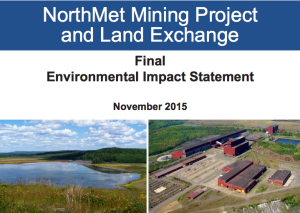
“[The Final EIS] demonstrates the project can meet all state and federal standards,” said Tom Landwehr, the commissioner of the Department of Natural Resources.
But at a press conference, Landwehr also stressed that he doesn’t mean PolyMet is guaranteed to receive permits. “It’s premature to assume that project will go forward,” Landwehr said. “That will come in permitting.”
The public will have about 30 days to review and comment on the 3,000-page document, then the DNR will decide whether or not the EIS is adequate. Such a determination is expected by February 2016. If it is found acceptable, the next step would be to apply for the slew of state and federal permits required to operate the mine.
PolyMet and its supporters expressed optimism in a news release, emphasizing that the FEIS shows it can mine within the limits of environmental laws.
“Completion of the Final EIS is a huge milestone for PolyMet, for the Iron Range communities, and for the state of Minnesota,” said Jon Cherry, president and CEO. “It is the culmination of more than a decade of detailed analysis and thorough review from various state and federal regulatory agencies.”
Excited about the possibility of new jobs for the beleaguered region, one union leader voiced his support for the project.
“The promise of more than a thousand direct and indirect jobs for hardworking Minnesotans is just over the horizon and we’re eager to see this come to fruition. We have trust that the state and federal regulatory process will protect our environment and allow us the economic opportunities we need to prosper,” said Harry Melander, president of the Minnesota Building and Construction Trades Council.
Environmental groups were doubtful the new document will remedy past problems with the environmental review. Citing incorrect models, ambiguous predictions, and a lack of detail, some stated skepticism.
“The Final EIS, like the thousands of pages of documents before it, relies on faulty and misleading assumptions by PolyMet and its paid consultants,” WaterLegacy stated in a Facebook post. “The PolyMet sulfide mine would pollute drinking water, streams and wetlands for hundreds of years and increase methylmercury contamination of fish, impairing the developing brains of Minnesota babies and children.”
With the massive document only available for a few hours, others withheld judgment.
“We don’t know every detail of its contents, and we’ll be reviewing it closely,” said Scott Strand, Executive Director of the Minnesota Center for Environmental Advocacy. A statement from the Mining Truth coalition identified four areas it says need special attention: Storage of mine waste, water flow predictions based on incorrect data, funds to ensure reclamation after closure, and the possibility that hundreds of years of water treatment will be needed to prevent pollution into tributaries of the St. Louis River.
A DNR fact sheet states that the FEIS “assumes mechanical treatment would be required indefinitely at both the Mine Site and Plant Site.” Landwehr addressed that possibility at the news conference. While the state of Minnesota prohibits mines that would require “perpetual treatment,” the DNR Commissioner said he still believed the agency can legally allow the proposed centuries of mitigation.
“To be clear, state law says we can’t declare a mine closed until remediation is done,” Landwehr said. If the agency does not declare the mine officially “closed” until water treatment is unnecessary, it may also not be able to return to PolyMet any funds that the company provides for a “damage deposit.”
The FEIS and additional information is available on the DNR’s website. Public comments can be submitted electronically at NorthMetFEIS.dnr@state.mn.us or by mail to: Lisa Fay, EIS project manager, Minnesota DNR Ecological and Water Resources Division, Environmental Review Unit, 500 Lafayette Road, Box 25, St. Paul, MN 55155-4025.

